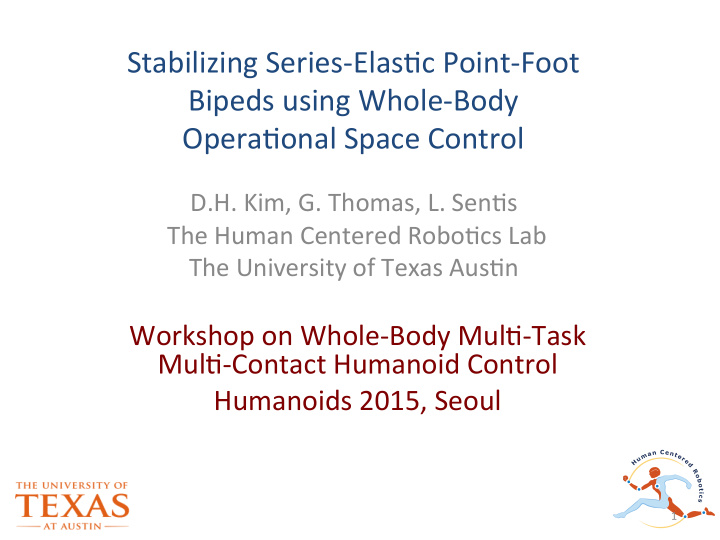



Stabilizing Series-Elas0c Point-Foot Bipeds using Whole-Body Opera0onal Space Control D.H. Kim, G. Thomas, L. Sen0s The Human Centered Robo0cs Lab The University of Texas Aus0n Workshop on Whole-Body Mul0-Task Mul0-Contact Humanoid Control Humanoids 2015, Seoul 1
Context • DRC extensively used WBCs • Locomo0on limita0ons • Speed and accuracy required • SEA-based humanoid robots sought for safety and mul0contact 2
Goals Devising a WBOSC strategy for point-foot bipedal robots Formula0ng force feedback control of internal forces Experimen0ng with mo0on and force behaviors over disjointed terrains using WBOSC Formula0ng planning algorithms for achieving unsupported dynamic balancing 3
Terminology: Whole-Body Opera0onal Space Control (WBOSC) • “Whole-Body Control” (WBC) was an older terminology we used prior to the crea0on of the IEEE-RAS Technical Commi]ee on Whole-Body Control. We decided to use “Whole- Body Opera0onal Space Control” • WBOSC formulates dynamically-consistent floa0ng- based priori0zed task mo0on and internal force torque-controllers. 4
Basic Equa0ons of WBOSC Floa0ng base whole-body dynamics with contact supports Support consistent task differen0al kinema0cs Support consistent task differen0al kinema0cs 5
(Cont’d) Task-level accelera0on control structure Internal wrench control structure Mapping between reac0on and internal wrenches 6
Equivalent Op0miza0on 7
Significance of Work • WBOSC is newly formulated for elas0c point-foot bipedal robots • WBCs can be easily transferred between robots • Some WBCs decouple task dynamics • WBOSC enables feedback control of mo0on tasks and internal force behaviors • Point-foot bipeds do not have a suppor0ng polygon 8
Technical Procedure • Devise methods to achieve stable and accurate whole-body opera0onal space • Feedback control of internal forces for pulling or pushing on terrains • IMU-Mocap sensor fusion for pose es0ma0on • Locomo0on planning and control to stabilize point- foot robot on various terrains 9
Treatment of Contact Forces on WBCs • Full Body Controller of SARCOS CMU. First solves for contact forces using approximate QP then solves full- body constrained inverse dynamics problem. • The Momentum-Based Controller of IHMC has also 2 stages, but solves for joint accelera0ons using the centroidal momentum matrix. 10
Treatment of Contact Forces on WBOSC • WBOSC divides contact forces into mo0on tasks and internal forces • Relies on conver0ng desired contact forces to internal forces • Contact solver based on mul0contact matrix, or exis0ng QP solvers • Using feedback to control of internal forces which overcomes reduce torque control effort 11
Pros/Cons WBOSC Pros: • Can accomplish accurate contact force control regardless of joint torque controllers • Priori0es allows behaviors to automa0cally repress conflic0ng tasks • Dynamic correctness • Supports the execu0on of overdetermined tasks • Exposes task’s effec0ve iner0a Cons: • Necessitates to convert desired contact forces to internal forces • Lack of inequality constraints 12
SOTA Point Foot Bipeds • ATRIAS achieves unsupported dynamic walking without reliance on WBCs. It has not been shown to regulate internal forces on disjointed terrains. It does not control yaw moments, instead relying on small passive feet. • MARLO achieves 20 steps of unsupported dynamic walking. In comparison, Hume achieves 18 steps of unsupported balance. 13
Some Points about Hardware • Hume, 1.5m, 20Kg, 6 DoF SEAs – Difficul0es: high s0c0on, flexible structure • Low latency Microstrain 3DM-GX3-25-OEM – Difficul0es: large ini0al bias error and noise density • Phase space impulse mocap – Difficul0es: suffers from occlusions and large latencies (5ms) • WBOSC running at 0.667ms, end to end, EtherCat, RTAI Linux. DSPs perform torque control at 2KHz. 14
End to end controller
End to end controller Task Controller
End to end controller
Opera0onal Space Trajectory Single Support Double Support
End to end controller
High Level Posi0on (PID) PID control
End to end controller
Contact Switching Transi0on Reac0on Force Double Support Single Support
Experiment Result
End to end controller Internal Force Control
Internal Force Control Internal force: mutually canceling forces and moments between pairs or groups of contact points, i.e. tensions, compressions and reac0on moments
Internal Force Control Fully controllable - orthogonal to the robot’s mo0on
Internal Force Control Fully controllable - orthogonal to the robot’s mo0on `
How to Design Internal Force In our experiment, simple geometry is used Op0miza0on based methods (QP) are also possible op0on
Internal Forces Experiment
Joint Torque Control
Problem Defini0on Reference (given) Measurement We are finding:
Formula0on of The Problem 1 st row of : Therefore, we can rewrite the equa0ons:
Include More Informa0on Then simply take the pseudo inverse: But we need to think the followings: • LED occlusion: Ignore some0mes • How to mix MoCap with IMU data (fast although noisy) • Substan0al delay in the MoCap data
How to Mix with IMU data p want to find with MoCap & IMU data Previous es0mated value
Sensor Fusion &
Velocity Reversal Foot Placement Planner
Unsupported Balance Experiment
Thank you for your a]en0on!
Impact Model (op0onal) when (ordinary landing speed),
Recommend
More recommend